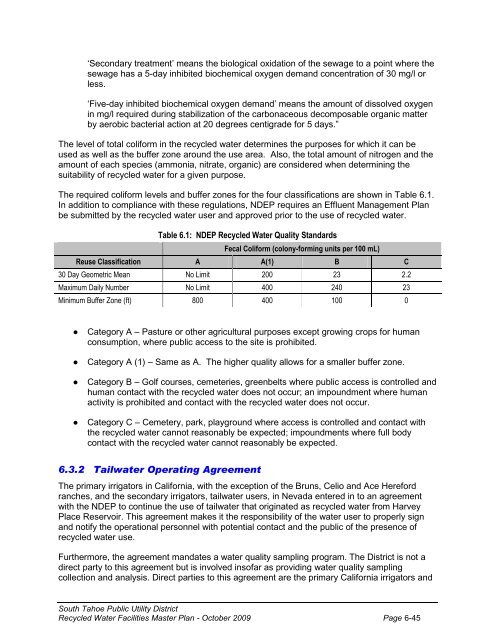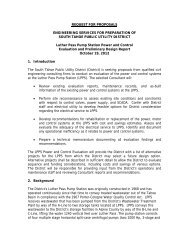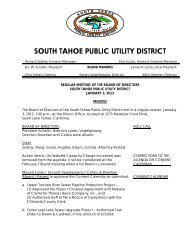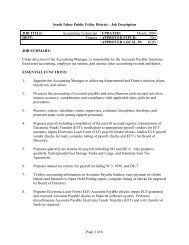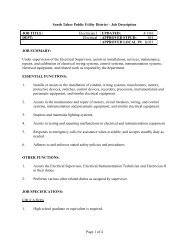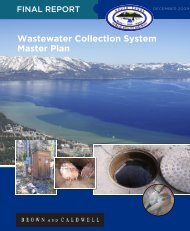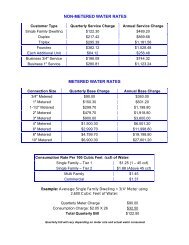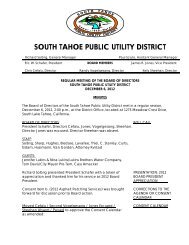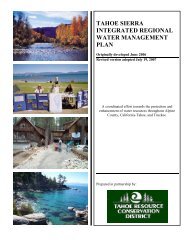October 2009 - South Tahoe Public Utility District
October 2009 - South Tahoe Public Utility District
October 2009 - South Tahoe Public Utility District
Create successful ePaper yourself
Turn your PDF publications into a flip-book with our unique Google optimized e-Paper software.
„Secondary treatment‟ means the biological oxidation of the sewage to a point where the<br />
sewage has a 5-day inhibited biochemical oxygen demand concentration of 30 mg/l or<br />
less.<br />
„Five-day inhibited biochemical oxygen demand‟ means the amount of dissolved oxygen<br />
in mg/l required during stabilization of the carbonaceous decomposable organic matter<br />
by aerobic bacterial action at 20 degrees centigrade for 5 days.”<br />
The level of total coliform in the recycled water determines the purposes for which it can be<br />
used as well as the buffer zone around the use area. Also, the total amount of nitrogen and the<br />
amount of each species (ammonia, nitrate, organic) are considered when determining the<br />
suitability of recycled water for a given purpose.<br />
The required coliform levels and buffer zones for the four classifications are shown in Table 6.1.<br />
In addition to compliance with these regulations, NDEP requires an Effluent Management Plan<br />
be submitted by the recycled water user and approved prior to the use of recycled water.<br />
Table 6.1: NDEP Recycled Water Quality Standards<br />
Fecal Coliform (colony-forming units per 100 mL)<br />
Reuse Classification A A(1) B C<br />
30 Day Geometric Mean No Limit 200 23 2.2<br />
Maximum Daily Number No Limit 400 240 23<br />
Minimum Buffer Zone (ft) 800 400 100 0<br />
●<br />
●<br />
●<br />
●<br />
Category A – Pasture or other agricultural purposes except growing crops for human<br />
consumption, where public access to the site is prohibited.<br />
Category A (1) – Same as A. The higher quality allows for a smaller buffer zone.<br />
Category B – Golf courses, cemeteries, greenbelts where public access is controlled and<br />
human contact with the recycled water does not occur; an impoundment where human<br />
activity is prohibited and contact with the recycled water does not occur.<br />
Category C – Cemetery, park, playground where access is controlled and contact with<br />
the recycled water cannot reasonably be expected; impoundments where full body<br />
contact with the recycled water cannot reasonably be expected.<br />
6.3.2 Tailwater Operating Agreement<br />
The primary irrigators in California, with the exception of the Bruns, Celio and Ace Hereford<br />
ranches, and the secondary irrigators, tailwater users, in Nevada entered in to an agreement<br />
with the NDEP to continue the use of tailwater that originated as recycled water from Harvey<br />
Place Reservoir. This agreement makes it the responsibility of the water user to properly sign<br />
and notify the operational personnel with potential contact and the public of the presence of<br />
recycled water use.<br />
Furthermore, the agreement mandates a water quality sampling program. The <strong>District</strong> is not a<br />
direct party to this agreement but is involved insofar as providing water quality sampling<br />
collection and analysis. Direct parties to this agreement are the primary California irrigators and<br />
<strong>South</strong> <strong>Tahoe</strong> <strong>Public</strong> <strong>Utility</strong> <strong>District</strong><br />
Recycled Water Facilities Master Plan - <strong>October</strong> <strong>2009</strong> Page 6-45


